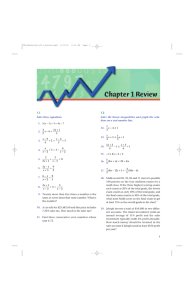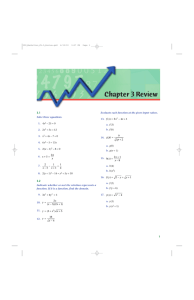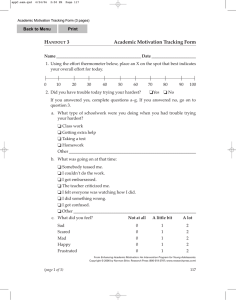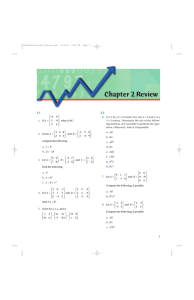4.1 4.2
advertisement
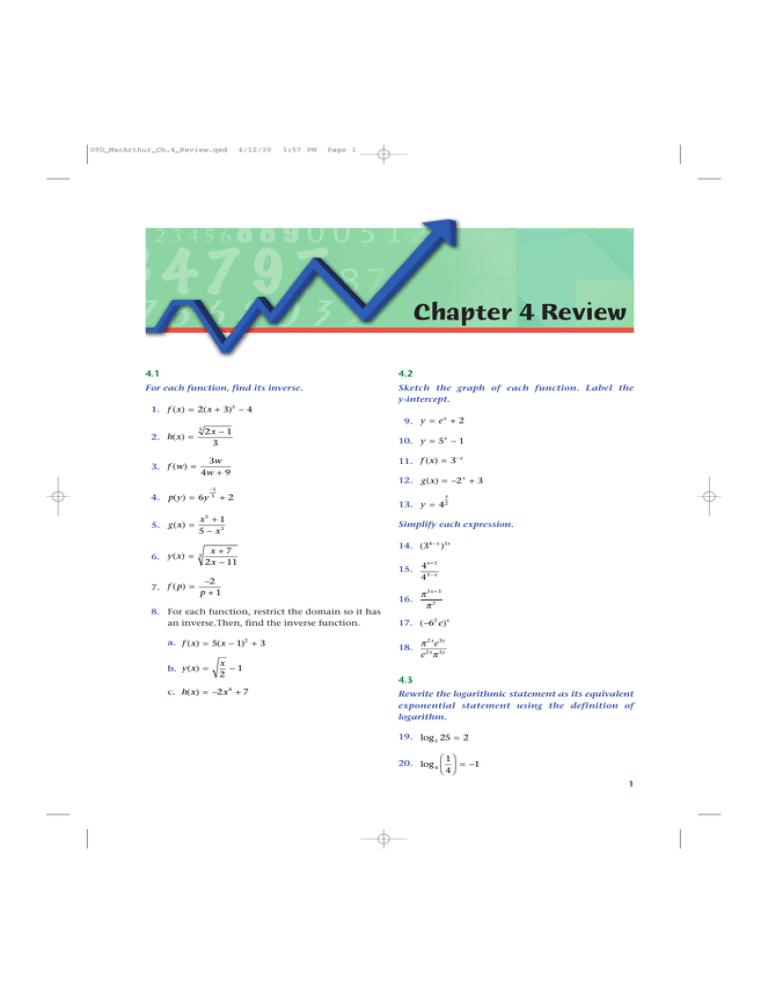
09D_MacArthur_Ch.4_Review.qxd 4/12/10 3:57 PM Page 1 Chapter 4 Review 4.1 4.2 For each function, find its inverse. Sketch the graph of each function. Label the y-intercept. 1. f ( x) = 2( x + 3)3 − 4 x 9. y = e + 2 2. h( x) = 3. f ( w ) = 5 2x − 1 3 3w 4w + 9 10. y = 5x − 1 −x 11. f ( x) = 3 12. g ( x) = −2 x + 3 −1 4. p( y ) = 6y 3 + 2 5. g ( x) = 6. y( x) = 7. f ( p) = x3 + 1 5 − x3 3 x+7 2 x − 11 −2 p+1 8. For each function, restrict the domain so it has an inverse.Then, find the inverse function. a. f ( x) = 5( x − 1)2 + 3 b. y( x) = x −1 2 c. h( x) = −2 x4 + 7 x 13. y = 4 2 Simplify each expression. 14. (34 − x )3 x x +1 15. 4 43 − x 16. π 5x + 3 π2 17. ( −62 e )x 18. π 2 xe 3y e 2 xπ 3 y 4.3 Rewrite the logarithmic statement as its equivalent exponential statement using the definition of logarithm. 19. log 5 25 = 2 1 20. log 4 = −1 4 1 09D_MacArthur_Ch.4_Review.qxd 2 4/12/10 3:57 PM Page 2 Chapter 4 Review 21. log 1 = 0 37. 3 ln(e x ) − ln x2 + ln(5x − 2 ) 1 1 22. ln = − 2 e 38. log(4x) + log(5y ) − log( xy ) Simplify each expression, without using a calculator. x 39. log 5 ( x2 − 5) + 3 log 5 x − log 5 2 Evaluate each expression, without using a calculator. 23. log8 1 24. log2 16 25. ln e –5 1 40. 3 ln e − ln 1 + ln + ln e 5 e 1 26. log 3 81 120(24) 41. log 4 − log 5 625 + log 1000 18(40) For each function, find the domain and sketch the graph. Label the x-intercept. 42. log 2 (2 π ) + log π (π 2 ) − ln(e 3 ) 27. f ( x) = log 3 ( − x) 4.5 28. y = log( x − 2 ) Solve each equation. 29. g ( x) = ln( x) + 3 43. 2e 5 x − 3 = 9 30. h( x) = 2 log 5 ( x) − 1 44. 5x 53 x = 510 31. y = − log 2 ( x + 1) 45. 3x + 1 + 2 = 4(3x + 1 ) − 7 2 3w + 5 + 1 = 20 + 46. 2 4.4 Use properties of logarithms to expand each expression completely. x2 + 5 32. log 3 x 4 ( x − 1)4 33. ln x2 3 x + 9 ( x + 1)2 ( x − 2 )3 ( x + 3)4 34. log 5 x 1 16 47. 2(e 2 x − 10) = −3e x 48. log 4 5 + log 4 x = log 4 (3x + 10) 49. log 2 x2 − log 2 ( x + 5) = 2 50. log x + log( x + 5) = log 66 51. e ln( x 2 + x) = 90 52. ln( x + 2 ) = ln( x + 1) + 3 Use properties of logarithms to condense each expression completely. 1 53. 3 = log 5 ( x + 2 ) + log 5 x 35. 3 log 2 x − 4 log 2 ( x + 5) + log 2 9 54. 2 x10 x = x2 10 x 36. 1 1 log 4 ( x − 3) + log 4 x − log 4 ( x ) 2 4 09D_MacArthur_Ch.4_Review.qxd 4/12/10 3:57 PM Page 3 Chapter 4 Review 4.6 55. Suppose the number of rabbits on a small island t is given by N = 400(0.10.2 ), where t is the number of years after 2005. a. How many rabbits are on the island in 2005? b. How many rabbits are on the island in 2006? c. In the year 2020, what will the rabbit population be? 56. The number N of people in a community who are reached by a particular rumor at time t (in 680 days) is given by N (t ) = . 1 + 169e –0.4t a. Find N(0), the number of people who initially know the rumor. b. How long will it take 340 people to know the rumor? 57. The demand function for a product is given by −q p = 180(4 15 ) . 3 60. The quantity, measured in milligrams, of a radioactive substance present after t years is given by q = 180e – 0.04t. After how many years will there be 14 mg present? 61. The population of Mathville, with initial population of 14,000 in the year 2000, grows at a rate of 3% per year. a. What is the population function?(Let P = population and t = number of years past year 2000.) b. What is the population in 2002? c. In what year will the population be 35,000? 62. Melida saved $5,000 from her weekly cash over the last two years. She wants to invest her money in an account that grows according to the formula A(t) = P(1.052t ), where P is the original amount invested, t is the number of years she leaves her money in that account and A is the value of that account at time t. a. At what price will there be 2 units demanded? a. How much will the account be worth after two years? b. If the unit price is $110, how many units will be demanded? b. After how many years will she have $8,500? 58. The half-life of radioactive radium is 1620 years. What percent of a present amount of radioactive radium will remain after 870 years? 59. The number of units of a product sold after t years is given by n(t) = 150(0.20.03t ). After how many years will there be 125 units sold? 09D_MacArthur_Ch.4_Review.qxd 4/12/10 3:57 PM Page 4 09D_MacArthur_Ch.4_Review.qxd 4/12/10 3:57 PM Page 5 Chapter 4 Review CHAPTER 4 REVIEW ANSWER KEY x+4 −3 2 1. f −1( x) = 3 2. h−1( x) = (3x)5 + 1 2 3. f −1( w ) = 9w 2 3 − 4w 4. p−1( y ) = 216 ( y − 2 )3 −1 12. (0,2) 13. (0,1) 5x − 1 x+1 5. g ( x) = 3 6. y −1( x) = 7 + 11x3 2 x3 − 1 2 7. f ( p) = −1 − p −1 8. a. domain: x ≥ 1; f −1( x) = x−3 +1 5 −1 b. domain: x ≥ −1; y ( x) = 2( x + 1) c. domain: x ≥ 0; h−1( x) = 9. (0,3) 2 4 7−x 2 14. 15. 16. 17. π 18. e 2 x − 3y 19. 52 = 25 1 −1 20. 4 = 4 21. 10 0 = 1 1 − 1 22. e 2 = e 23. 24. 25. 26. 27. 10. 2 312x – 3x 4 2x – 2 π5x + 1 (–36)x ex 0 4 –5 –4 domain: x < 0 (0,0) (–1,0) 11. 28. domain: x > 2 (0,1) (3,0) 5 09D_MacArthur_Ch.4_Review.qxd 6 4/12/10 3:57 PM Page 6 Chapter 4 Review 29. domain: x > 0 1 ( 3 ,0) e 30. domain: x > 0 (M5 ,0) 31. domain: x > –1 (0,0) 2 32. 4 log( x + 5) − 12 log x 33. 2 ln x + 4 1 ln( x − 1) − ln( x + 9) 3 3 34. 2 log 5 ( x + 1) + 3 log 5 ( x − 2 ) + 4 log 5 ( x + 3) − log 5 x 9x 3 35. log 2 4 ( x + 5) x − 3 36. log 4 4 x e 3 x (5x − 2 ) 37. ln x2 38. 39. 40. 41. 42. log (20) log5 (2x2(x2 – 5)) 7.5 0 π–1 ln 6 43. x = 5 44. x = 2, –5 45. x = 0 46. w = –3 5 47. x = ln 2 48. 49. 50. 51. x=5 x = 2 ± 26 x=6 x = 9, –10 52. x = e3 − 2 ≈ −0.9476 1 − e3 53. x = 1 62 54. x = 0, 2 55. a. 40 b. ~252 c. 400 56. a. 4 b. ~13 days 57. a. $149.62 b. ~5 units 58. 68.9% 59. ~4 years 60. ~64 years 61. a. P = 14000e 0.03t b. ~14866 c. 2031 62. a. $6077.53 b. ~5.44 years



